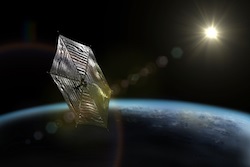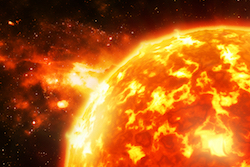New instruments for the European Solar Telescope
Founded in 2006 by a group of solar physicists from 14 European countries, the European Association for Solar Telescopes (EAST) aims to provide solar physicists with access to world-class high-resolution ground-based observing facilities. To this end, EAST intends to develop and operate a next-generation large-aperture EST in the Canary Islands. EST will be a 4-metre class solar telescope that will be used to further understand the magnetic coupling between the deep photosphere and upper chromosphere. This will require improving diagnostics capability of the thermal, dynamic and magnetic properties of the plasma over many scale heights by using multiple wavelength imaging, spectroscopy and spectropolarimetry. European solar physicists unanimously share the view that a large-aperture new-generation solar telescope is needed to further understand the fundamental processes of plasma physics in the Sun’s upper layers. Supported by EAST and funded by the EU, the SOLARNET(opens in new window) (High-resolution solar physics network) project was initiated to ensure that all European solar physicists have access to state-of-the-art facilities and data repositories. Joint research activities were aimed at developing tools and prototypes for innovative data instruments and data processing and access. Keeping Europe at the forefront of solar physics In practically all areas and disciplines and so too in solar physics, Europe has public or private research centres allowing highly skilled researchers to conduct cutting-edge world-class research. Several European research institutes have achieved a high level of competence in developing sophisticated scientific instruments and this has given them a high profile in the area of ground-based observation technology. Robust partnerships with industry also help confront engineering challenges of existing and next-generation telescopes. ‘Together, researchers successfully developed a number of innovative instrument prototypes to define the future instruments of EST. These prototypes were designed and constructed using present telescopes as test beds to demonstrate their performance,’ says project coordinator Manuel Collados. An innovative heat rejector prototype for the GREGOR solar telescope was fabricated. This heat rejector follows the concept of the design proposed for the EST and thus represents a proof of concept for the technical solution proposed for this new large facility. Another project achievement has been the development of a large tuneable Fabry-Perot interferometer prototype 150 mm in diameter. This activity represents an important step towards the optimisation of such devices for use in instrumentation tailored for large solar telescopes like the EST. Two prototypes of integral field units to obtain spatially resolved spectra of all points in a 2D region were constructed for the GREGOR and the Swedish Solar Telescope (SST). The first one is based on an image slicer optimised for GRIS – the GREGOR infrared spectrograph. The other one uses microlenses to feed the TRIPPEL spectrograph of the SST. Both prototypes were successfully tested at the corresponding telescopes and validated these concepts for EST instrumentation. A fast solar polarimeter was also designed and tested along with a new polarising beam splitter using novel detector concepts. Solar physics in the big data era SOLARNET brought together all data science fellows working with SOLARNET telescope data, as well as United States data scientists working with data regarding the upcoming 4-metre solar telescope DKIST in Hawaii. The project worked to establish consistency in data and issued guidelines with general recommendations so that external observers can easily get their data reduced to facilitate posterior analysis. ‘Thanks to SOLARNET, there are now modern data pipelines for all major European solar instruments,’ says Mr Collados. All project activities brought together European and United States solar physicists to ensure participation of the widest possible community for this revolutionary ground-based telescope. When it becomes a reality, this 4-metre ground-based EST will allow observation of solar phenomena with unprecedented accuracy and resolution of only a few tens of kilometres at the solar surface.







